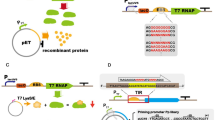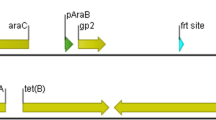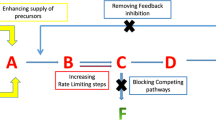Abstract
The combination of Escherichia coli BL21 (DE3) and the pET expression system is used extensively for the expression of various recombinant proteins (RPs). However, RP overexpression often introduces a growth burden for the host, especially in the case of toxic proteins. The key to solving this problem is to reduce the host burden associated with protein overproduction, which is often achieved by regulating the expression or activity of T7 RNAP or growth-decoupled systems. However, these strategies mainly relieve or interrupt the robbing of host resources, and do not eliminate other types of host burdens in the production process. In this study, we constructed a production system based on a dynamic equilibrium to precisely relieve the host burden and increase the RP production. The system is composed of three modules, including the overexpression of basic growth-related genes (rRNA, RNAP core enzyme, sigma factors), prediction and overexpression of key proteins using the enzyme-constrained model ec_iECBD_1354, and dynamic regulation of growth-related and key protein expression intensity based on a burden-driven promoter. Using this system, the production of many high-burden proteins, including autolysis protein and E. coli membrane proteins, was increased to varying degrees. Among them, the cytosine transporter protein (CodB) was most significantly improved, with a 4.02-fold higher production compared to the wild strain. This system can effectively reduce the optimizing costs, and is suitable for developing various types of RP expression hosts rapidly.
Key points
• The basic growth-related resources can relieve the host burden from recombinant protein.
• The enzyme-constrained model can accurately predict key genes to improve yield.
• The expression intensity can be dynamically adjusted with changes in burden.
Graphical abstract






Similar content being viewed by others
Data availability
The authors can confirm that all relevant data are included in the article and supplementary information files.
References
Baumschlager A, Aoki SK, Khammash M (2017) Dynamic blue light-inducible T7 RNA polymerases (Opto-T7RNAPs) for precise spatiotemporal gene expression control. ACS Synth Biol 6(11):2157–2167. https://doi.org/10.1021/acssynbio.7b00169
Camacho DM, Collins KM, Powers RK, Costello JC, Collins JJ (2018) Next-generation machine learning for biological networks. Cell 173(7):1581–1592. https://doi.org/10.1016/j.cell.2018.05.015
Ceroni F, Algar R, Stan G-B, Ellis T (2015) Quantifying cellular capacity identifies gene expression designs with reduced burden. Nat Methods 12(5):415–418. https://doi.org/10.1038/NMETH.3339
Ceroni F, Boo A, Furini S, Gorochowski TE, Borkowski O, Ladak YN, Awan AR, Gilbert C, Stan G-B, Ellis T (2018) Burden-driven feedback control of gene expression. Nat Methods 15(5):387–393. https://doi.org/10.1038/nmeth.4635
Chee WKD, Yeoh JW, Dao VL, Poh CL (2022) Highly reversible tunable thermal-repressible split-T7 RNA polymerases (thermal-T7RNAPs) for dynamic gene regulation. ACS Synth Biol 11(2):921–937. https://doi.org/10.1021/acssynbio.1c00545
Choi JH, Lee SJ, Lee SJ, Lee SY (2003) Enhanced production of insulin-like growth factor I fusion protein in Escherichia coli by coexpression of the down-regulated genes identified by transcriptome profiling. Appl Environ Microbiol 69(8):4737–4742. https://doi.org/10.1128/AEM.69.8.4737-4742.2003
Darlington AP, Kim J, Jiménez JI, Bates DG (2018) Dynamic allocation of orthogonal ribosomes facilitates uncoupling of co-expressed genes. Nat Commun 9(1):1–12. https://doi.org/10.1038/s41467-018-02898-6
Dong T, Yu R, Schellhorn H (2011) Antagonistic regulation of motility and transcriptome expression by RpoN and RpoS in Escherichia coli. Mol Microbiol 79(2):375–386. https://doi.org/10.1111/j.1365-2958.2010.07449.x
Dvorak P, Chrast L, Nikel PI, Fedr R, Soucek K, Sedlackova M, Chaloupkova R, de Lorenzo V, Prokop Z, Damborsky J (2015) Exacerbation of substrate toxicity by IPTG in Escherichia coli BL21 (DE3) carrying a synthetic metabolic pathway. Microb Cell Fact 14(1):1–15. https://doi.org/10.1186/s12934-015-0393-3
Feilmeier BJ, Iseminger G, Schroeder D, Webber H, Phillips GJ (2000) Green fluorescent protein functions as a reporter for protein localization in Escherichia coli. J Bacteriol 182(14):4068–4076. https://doi.org/10.1128/JB.182.14.4068-4076.2000
Feng J, Gu Y, Quan Y, Cao M, Gao W, Zhang W, Wang S, Yang C, Song C (2015) Improved poly-γ-glutamic acid production in Bacillus amyloliquefaciens by modular pathway engineering. Metab Eng 32(2015):106–115. https://doi.org/10.1016/j.ymben.2015.09.011
Gerosa L, Kochanowski K, Heinemann M, Sauer U (2013) Dissecting specific and global transcriptional regulation of bacterial gene expression. Mol Syst Biol 9(1):658–668. https://doi.org/10.1038/msb.2013.14
Glick BR (1995) Metabolic load and heterologous gene expression. Biotechnol Adv 13(2):247–261. https://doi.org/10.1016/0734-9750(95)00004-a
Han MJ, Park SJ, Park TJ, Lee SY (2004) Roles and applications of small heat shock proteins in the production of recombinant proteins in Escherichia coli. Biotechnol Bioeng 88(4):426–436. https://doi.org/10.1002/bit.20227
Heyland J, Blank LM, Schmid A (2011) Quantification of metabolic limitations during recombinant protein production in Escherichia coli. J Biotechnol 155(2):178–184. https://doi.org/10.1016/j.jbiotec.2011.06.016
Hjelm A, Schlegel S, Baumgarten T, Klepsch M, Wickstrom D, Drew D, de Gier J-W (2013) Optimizing E. coli-based membrane protein production using Lemo21(DE3) and GFP-fusions. Methods Molec Biol (Clifton, NJ) 1033:381–400. https://doi.org/10.1007/978-1-62703-487-6_24
Iost I, Guillerez J, Dreyfus M (1992) Bacteriophage T7 RNA polymerase travels far ahead of ribosomes in vivo. J Bacteriol 174(2):619–622. https://doi.org/10.1128/jb.174.2.619-622.1992
Izard J, Gomez Balderas CD, Ropers D, Lacour S, Song X, Yang Y, Lindner AB, Geiselmann J, de Jong H (2015) A synthetic growth switch based on controlled expression of RNA polymerase. Mol Syst Biol 11(11): 840–856. https://doi.org/10.15252/msb.20156382
Jiang Y, Chen B, Duan C, Sun B, Yang J, Yang S (2015) Multigene editing in the Escherichia coli genome via the CRISPR-Cas9 system. Appl Environ Microbiol 81(7):2506–2514. https://doi.org/10.1128/AEM.04023-14
Kaur J, Kumar A, Kaur J (2018) Strategies for optimization of heterologous protein expression in E-coli: roadblocks and reinforcements. Int J Biol Macromol 106:803–822. https://doi.org/10.1016/j.ijbiomac.2017.08.080
Kim H, Kim S, Yoon SH (2018) Metabolic network reconstruction and phenome analysis of the industrial microbe, Escherichia coli BL21 (DE3). PLoS ONE 13(9):1–21. https://doi.org/10.1371/journal.pone.0204375
King ZA, Lu J, Dräger A, Miller P, Federowicz S, Lerman JA, Ebrahim A, Palsson BO, Lewis NE (2016) BiGG Models: a platform for integrating, standardizing and sharing genome-scale models. Nucleic Acids Res 44(D1):D515–D522. https://doi.org/10.1093/nar/gkv1049
Klepsch MM, Persson JO, De Gier J-WL (2011) Consequences of the overexpression of a eukaryotic membrane protein, the human KDEL receptor Escherichia Coli. J Mol Biol 407(4):532–542. https://doi.org/10.1016/j.jmb.2011.02.007
Klumpp S, Hwa T (2008) Growth-rate-dependent partitioning of RNA polymerases in bacteria. Proc Natl Acad Sci USA 105(51):20245–20250. https://doi.org/10.1073/pnas.0804953105
Kumar J, Chauhan AS, Shah RL, Gupta JA, Rathore AS (2020) Amino acid supplementation for enhancing recombinant protein production in E. coli. Biotechnol Bioeng 117(8):2420–2433. https://doi.org/10.1002/bit.27371
Lewis NE, Schramm G, Bordbar A, Schellenberger J, Andersen MP, Cheng JK, Patel N, Yee A, Lewis RA, Eils R (2010) Large-scale in silico modeling of metabolic interactions between cell types in the human brain. Nat Biotechnol 28(12):1279–1285. https://doi.org/10.1038/nbt.1711
Li S, Jendresen CB, Grünberger A, Ronda C, Jensen SI, Noack S, Nielsen AT (2016) Enhanced protein and biochemical production using CRISPRi-based growth switches. Metab Eng 38:274–284. https://doi.org/10.1016/j.ymben.2016.09.003
Li ZJ, Zhang ZX, Xu Y, Shi TQ, Ye C, Sun XM, Huang H (2022) CRISPR-based construction of a BL21 (DE3)-derived variant strain library to rapidly improve recombinant protein production. ACS Synth Biol 11(1):343–352. https://doi.org/10.1021/acssynbio.1c00463
Li ZP, Geffers R, Jain G, Klawonn F, Kokpinar O, Nimtz M, Schmidt-Heck W, Rinas U (2021) Transcriptional network analysis identifies key elements governing the recombinant protein production provoked reprogramming of carbon and energy metabolism in Escherichia coli BL21 (DE3). Eng Rep 3(9):12393–12416. https://doi.org/10.1002/eng2.12393
Li ZP, Rinas U (2020) Recombinant protein production associated growth inhibition results mainly from transcription and not from translation. Microb Cell Fact 19(1):1–11. https://doi.org/10.1186/s12934-020-01343-y
Liang X, Li CM, Wang WY, Li Q (2018) Integrating T7 RNA polymerase and its cognate transcriptional units for a host-independent and stable expression system in single plasmid. ACS Synth Biol 7(5):1424–1435. https://doi.org/10.1021/acssynbio.8b00055
Mairhofer J, Scharl T, Marisch K, Cserjan-Puschmann M, Striedner G (2013) Comparative transcription profiling and in-depth characterization of plasmid-based and plasmid-free Escherichia coli expression systems under production conditions. Appl Environ Microbiol 79(12):3802–3812. https://doi.org/10.1128/AEM.00365-13
Massaiu I, Pasotti L, Sonnenschein N, Rama E, Cavaletti M, Magni P, Calvio C, Herrgård MJ (2019) Integration of enzymatic data in Bacillus subtilis genome-scale metabolic model improves phenotype predictions and enables in silico design of poly-γ-glutamic acid production strains. Microb Cell Fact 18(1):1–20. https://doi.org/10.1186/s12934-018-1052-2
Merrick M (1993) In a class of its own—the RNA polymerase sigma factor σ; 54 (σN). Mol Microbiol 10(5):903–909. https://doi.org/10.1111/j.1365-2958.1993.tb00961.x
Miroux B, Walker JE (1996) Over-production of proteins in Escherichia coli: mutant hosts that allow synthesis of some membrane proteins and globular proteins at high levels. J Mol Biol 260(3):289–298. https://doi.org/10.1006/jmbi.1996.0399
Monk JM, Charusanti P, Aziz RK, Lerman JA, Premyodhin N, Orth JD, Feist AM, Palsson BØ (2013) Genome-scale metabolic reconstructions of multiple Escherichia coli strains highlight strain-specific adaptations to nutritional environments. Proc Natl Acad Sci USA 110(50):20338–20343. https://doi.org/10.1073/pnas.1307797110
Morra R, Shankar J, Robinson CJ, Halliwell S, Butler L, Upton M, Hay S, Micklefield J, Dixon N (2016) Dual transcriptional-translational cascade permits cellular level tuneable expression control. Nucleic Acids Res 44(3):e21–e21. https://doi.org/10.1093/nar/gkv912
Ramchuran SO, Holst O, Karlsson EN (2005) Effect of postinduction nutrient feed composition and use of lactose as inducer during production of thermostable xylanase in Escherichia coli glucose-limited fed-batch cultivations. J Biosci Bioeng 99(5):477–484. https://doi.org/10.1263/jbb.99.477
Ranganathan S, Tee TW, Chowdhury A, Zomorrodi AR, Yoon JM, Fu Y, Shanks JV, Maranas CD (2012) An integrated computational and experimental study for overproducing fatty acids in Escherichia coli. Metab Eng 14(6):687–704. https://doi.org/10.1016/j.ymben.2012.08.008
Rosano GL, Ceccarelli EA (2014) Recombinant protein expression in Escherichia coli: advances and challenges. Front Microbiol 5:172–188. https://doi.org/10.3389/fmicb.2014.00172
Rosano GL, Morales ES, Ceccarelli EA (2019) New tools for recombinant protein production in Escherichia coli: a 5-year update. Protein Sci 28(8):1412–1422. https://doi.org/10.1002/pro.3668
Sánchez BJ, Zhang C, Nilsson A, Lahtvee PJ, Kerkhoven EJ, Nielsen J (2017) Improving the phenotype predictions of a yeast genome-scale metabolic model by incorporating enzymatic constraints. Mol Syst Biol 13(8): 935–950. https://doi.org/10.15252/msb.20167411
Schlegel S, Rujas E, Ytterberg AJ, Zubarev RA, Luirink J, De Gier J-W (2013) Optimizing heterologous protein production in the periplasm of E. coli by regulating gene expression levels. Microb Cell Fact 12(1):1–12. https://doi.org/10.1186/1475-2859-12-24
Schmidt M, Viaplana E, Hoffmann F, Marten S, Villaverde A, Rinas U (1999) Secretion-dependent proteolysis of heterologous protein by recombinant Escherichia coli is connected to an increased activity of the energy-generating dissimilatory pathway. Biotechnol Bioeng 66(1):61–67. https://doi.org/10.1002/(SICI)1097-0290(1999)66:1%3c61::AID-BIT6%3e3.3.CO;2-7
Shah MV, Nazem-Bokaee H, Antoney J, Kang SW, Jackson CJ, Scott C (2021) Improved production of the non-native cofactor F-420 in Escherichia coli. Sci Rep 11(1):1–16. https://doi.org/10.1038/s41598-021-01224-3
Shimada T, Furuhata S, Ishihama A (2021) Whole set of constitutive promoters for RpoN sigma factor and the regulatory role of its enhancer protein NtrC in Escherichia coli K-12. Microb Genom 7(11):1–27. https://doi.org/10.1099/mgen.0.000653
Silva F, Queiroz JA, Domingues FC (2012) Evaluating metabolic stress and plasmid stability in plasmid DNA production by Escherichia coli. Biotechnol Adv 30(3):691–708. https://doi.org/10.1016/j.biotechadv.2011.12.005
Stargardt P, Feuchtenhofer L, Cserjan-Puschmann M, Striedner G, Mairhofer J (2020) Bacteriophage inspired growth-decoupled recombinant protein production in Escherichia coli. ACS Synth Biol 9(6):1336–1348. https://doi.org/10.1021/acssynbio.0c00028
Studier FW (1991) Use of bacteriophage T7 lysozyme to improve an inducible T7 expression system. J Mol Biol 219(1):37–44. https://doi.org/10.1016/0022-2836(91)90855-Z
Sun XM, Zhang ZX, Wang LR, Wang JG, Liang Y, Yang HF, Tao RS, Jiang Y, Yang JJ, Yang S (2021) Downregulation of T7 RNA polymerase transcription enhances pET-based recombinant protein production in Escherichia coli BL21 (DE3) by suppressing autolysis. Biotechnol Bioeng 118(1):153–163. https://doi.org/10.1002/bit.27558
Tan S-I, Ng I-S (2020) New insight into plasmid-driven T7 RNA polymerase in Escherichia coli and use as a genetic amplifier for a biosensor. ACS Synth Biol 9(3):613–622. https://doi.org/10.1021/acssynbio.9b00466
Tan SI, Hsiang CC, Ng IS (2021) Tailoring genetic elements of the plasmid-driven T7 system for stable and robust one-step cloning and protein expression in broad Escherichia coli. ACS Synth Biol 10(10):2753–2762. https://doi.org/10.1021/acssynbio.1c00361
Terol GL, Gallego-Jara J, Martinez RAS, Vivancos AM, Diaz MC, Puente TD (2021) Impact of the expression system on recombinant protein production in Escherichia coli BL21. Front Microbiol 12:1–12. https://doi.org/10.3389/fmicb.2021.682001
Wagner S, Baars L, Ytterberg AJ, Klussmeier A, Wagner CS, Nord O, Nygren PA, van Wijk KJ, de Gier JW (2007) Consequences of membrane protein overexpression in Escherichia coli. Mol Cell Proteomics 6(9):1527–1550. https://doi.org/10.1074/mcp.M600431-MCP200
Wagner S, Klepsch MM, Schlegel S, Appel A, Draheim R, Tarry M, Högbom M, Van Wijk KJ, Slotboom DJ, Persson JO (2008) Tuning Escherichia coli for membrane protein overexpression. Proc Natl Acad Sci 105(38):14371–14376. https://doi.org/10.1073/pnas.0804090105
Wang M, Herrmann CJ, Simonovic M, Szklarczyk D, von Mering C (2015) Version 4.0 of PaxDb: protein abundance data, integrated across model organisms, tissues, and cell-lines. Proteomics 15(18):3163–3168. https://doi.org/10.1002/pmic.201400441
Wang ZK, Gong JS, Qin J, Li H, Lu ZM, Shi JS, Xu ZH (2021) Improving the intensity of integrated expression for microbial production. ACS Synth Biol 10(11):2796–2807. https://doi.org/10.1021/acssynbio.1c00334
Xu P (2018) Production of chemicals using dynamic control of metabolic fluxes. Curr Opin Biotechnol 53:12–19. https://doi.org/10.1016/j.copbio.2017.10.009
Ye C, Luo Q, Guo L, Gao C, Xu N, Zhang L, Liu L, Chen X (2020) Improving lysine production through construction of an Escherichia coli enzyme-constrained model. Biotechnol Bioeng 117(11):3533–3544. https://doi.org/10.1002/bit.27485
Funding
This work was supported by the Nature Science Foundation of Jiangsu Province (No. BK20202002, No. BK20190706) and the National Natural Science Foundation of China (No. 21908112, No. 22038007).
Author information
Authors and Affiliations
Contributions
XMS and HH designed the research. ZXZ, YZW, and FTN performed experiments. YX, CY, and YG analyzed data. ZXZ, YZW, and XMS wrote the paper. CY, YG, and HH supervised the research. All authors have read and approved the final manuscript.
Corresponding author
Ethics declarations
Ethical approval
This article does not contain any studies with human participants or animals performed by any of the authors.
Conflict of interest
The authors declare no competing interests.
Additional information
Publisher's note
Springer Nature remains neutral with regard to jurisdictional claims in published maps and institutional affiliations.
Supplementary Information
Below is the link to the electronic supplementary material.
Rights and permissions
Springer Nature or its licensor holds exclusive rights to this article under a publishing agreement with the author(s) or other rightsholder(s); author self-archiving of the accepted manuscript version of this article is solely governed by the terms of such publishing agreement and applicable law.
About this article
Cite this article
Zhang, ZX., Wang, YZ., Nong, FT. et al. Developing a dynamic equilibrium system in Escherichia coli to improve the production of recombinant proteins. Appl Microbiol Biotechnol 106, 6125–6137 (2022). https://doi.org/10.1007/s00253-022-12145-0
Received:
Revised:
Accepted:
Published:
Issue Date:
DOI: https://doi.org/10.1007/s00253-022-12145-0




